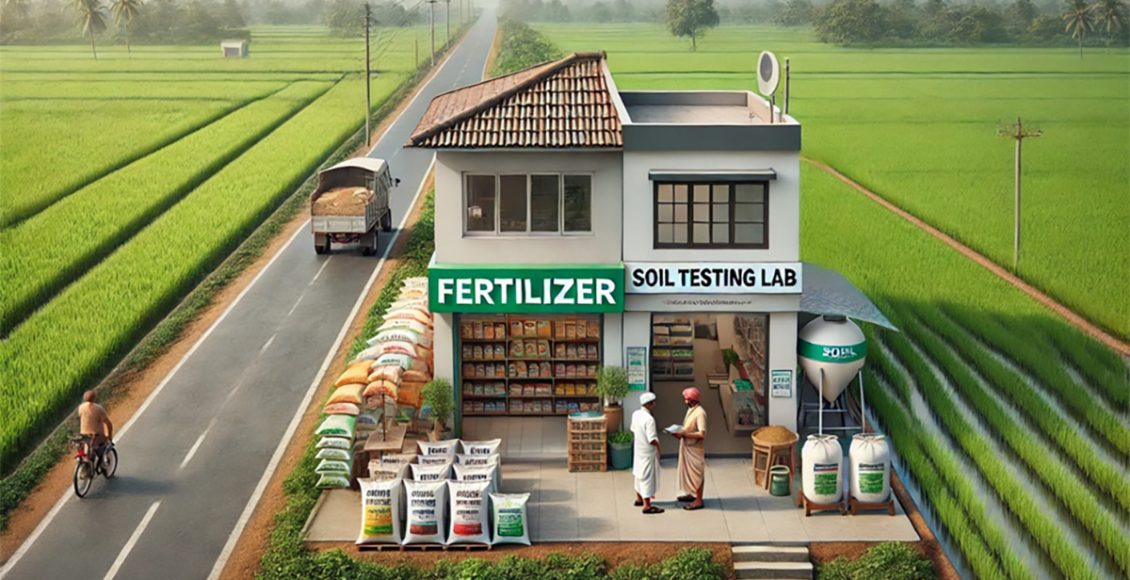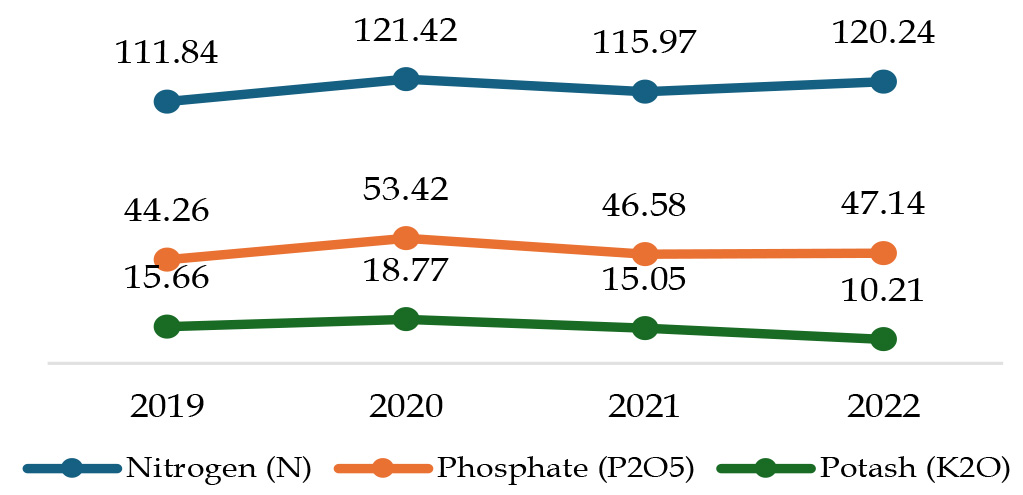
Fertilizer Efficiency in India: The Missing Link to Sustainable Agricultural Growth
Balanced Crop Nutrition is critical for achieving better yields and a pathway toward sustainable agricultural growth. Over the years, successive 5-year plans in India emphasized self-sufficiency and self-reliance in food grain production, and determined efforts in this direction led to a substantial increase in agricultural production. India ranks among the top three producers globally of several agricultural commodities. However, crop productivity for many economically significant crops remains low compared to global average yields.
Table 1: Comparative Productivity (Q/ha) of key crops across regions (F.A.O., 2022)
 India’s crop productivity, particularly for staples like rice, wheat, maize, oilseeds, pulses, and vegetables, significantly trails behind global averages (Table 1). For instance, rice and maize yields are 2-3 times lower than in North America and 1.3 times lower than in Europe. Although India is home to about 37% of the cotton area, its productivity levels are almost half that of the world average. However, crops like grapes, an export success, show that adopting proper crop nutrition practices can drive impressive results. Similarly, sugarcane cultivation in India has demonstrated substantial fertilizer consumption of ~330 Kg/ha. While high-yielding varieties and hybrids have been introduced across various crops, there remains vast untapped potential to enhance productivity through balanced crop nutrition, offering a pathway to more sustainable and efficient agriculture. Given the importance of these crops in Indian agriculture, appropriate nutrition must be provided to achieve noteworthy productivity levels.
India’s crop productivity, particularly for staples like rice, wheat, maize, oilseeds, pulses, and vegetables, significantly trails behind global averages (Table 1). For instance, rice and maize yields are 2-3 times lower than in North America and 1.3 times lower than in Europe. Although India is home to about 37% of the cotton area, its productivity levels are almost half that of the world average. However, crops like grapes, an export success, show that adopting proper crop nutrition practices can drive impressive results. Similarly, sugarcane cultivation in India has demonstrated substantial fertilizer consumption of ~330 Kg/ha. While high-yielding varieties and hybrids have been introduced across various crops, there remains vast untapped potential to enhance productivity through balanced crop nutrition, offering a pathway to more sustainable and efficient agriculture. Given the importance of these crops in Indian agriculture, appropriate nutrition must be provided to achieve noteworthy productivity levels.
Indian crop nutrition industry dynamics

Over the years, India has demonstrated a lower per capita nutrient (N, P, K) consumption of 141 Kg/Ha against 354 Kg/Ha by China, even though India ranks second in overall global consumption of nutrients. Consumption of nitrogenous fertilizers (urea) is significantly higher in India than in most other countries, accounting for over half of overall fertilizer consumption. Excessive use of urea is attributed to the predominance of cereal crops like rice and wheat in its crop production system, which accounts for 53% of total fertilizer consumption. Lack of knowledge among farmers about using balanced nutrition and government subsidy on urea are critical factors for its higher use. Overusing nitrogen and underusing phosphorous has created nutrient imbalances in Indian soils, and phosphorous deficiency becoming a growing concern. The government is encouraging the balanced use of potassium and phosphorous, particularly in regions where soils are severely deficient. Looking into nutrient-wise consumption trends per hectare, potash has declined compared to marginal growth in nitrogen and phosphate (Figure 1).
The Changing market dynamics
Crop nutrient use in India is steadily shifting towards non-urea fertilizers, driven by government initiatives to enhance soil fertility and growing awareness of the benefits of phosphatic and complex fertilizers. The increasing population, changing dietary preferences, and growing consumption of fruits, vegetables, seeds, and nuts for health reasons, biotic and abiotic stresses, and climate change necessitate customized crop nutrition products for sustainable productivity enhancement. The Indian fertilizer industry is expected to reach US$16.58 billion by 2032, with a CAGR of 4.3% from US$11.32 billion in 2023.
Conducive regulatory landscape: The government has gradually shifted from the product-based subsidy model to a nutrient-based subsidy (NBS) scheme, where subsidies are provided based on nutrient content rather than the quantity of the fertilizer product, encouraging balanced adoption of nutrients. Further, the government is aiming to drive fertilizer utilization and agricultural productiveness through schemes like the Pradhan Mantri Krishi Sinchayee Yojana (PMKSY) and Pradhan Mantri Kisan Urja Suraksha evam Utthaan Mahabhiyan (PM-KUSUM). The “Make in India” push has significantly increased domestic production of fertilizers products by more than 11%, particularly for Urea and NPK products. While NPK remains the core nutrient, the increasing focus on secondary and micronutrients will help address the country’s soil fertility issues. Adopting fortified fertilizers like NPK blends with zinc or sulfur is witnessing high adoption in areas with known nutrient deficiencies, providing comprehensive solutions for balanced fertilization.
Precision-driven innovative solutions: The gradual opening of markets for private players has spurred the introduction of innovative products. Government initiatives promoting balanced nutrient use have fuelled growth in the complex and specialty fertilizer segments. While NPK complex fertilizers are largely domestically produced, water-soluble fertilizers are primarily import-driven. Specialty fertilizers are gaining traction, including micronutrients, water-soluble variants, and slow/controlled-release fertilizers. Coated urea with sulfur or polymer layers ensures a gradual nitrogen release, improving efficiency and yields. Slow/controlled-release potassium-based fertilizers are also becoming popular in high-value crops like fruits, vegetables, and spices, enhancing nutrient uptake and reducing wastage, fostering sustainable agriculture. With an existing market share of 7 – 10% in the specialty and complex fertilizer segments, respectively, India is expected to grow by 5-8% in the next few years. Industry efforts to raise awareness about these innovative solutions and other emerging markets of nano-fertilizers and bio-fertilizers will drive the sector’s growth.
A plethora of technologies enabling fertilizer adoption and precise application: Technological advancements such as GIS, GPS, and satellite imagery enable farmers to apply fertilizers at the right time and place, optimizing nutrient use. Digital platforms and AgriTech solutions offer real-time crop nutrition guidance. IoT-enabled fertilizer management and fertigation systems boost productivity and promote sustainable farming practices. Maharashtra and Karnataka are leading states where farmers have successfully adopted fertigation systems for crops like grapes, tomatoes, and sugarcane, while in Rajasthan and Gujarat, where water is scarce, IoT-enabled fertigation systems have helped farmers reduce water consumption by up to 40-50% maintaining or even improving crop yields. Flower growers of Karnataka have benefited immensely from these systems, which helped them deliver export quality products. Companies like Fasal, Kheti Buddy, and AgroStar offer platforms that integrate IoT sensors, soil monitoring, and fertigation systems to help farmers optimize input use.
Farmers in these regions, particularly rice, wheat, and horticultural growers, have seen yield increases of 8-10% and reduced input costs by 15-25% through SHC-recommended fertilizer use.
The Soil Health Card (SHC) scheme, launched in 2015, has become a key driver of better soil management and improved fertilizer use in India. Over 23 crore SHCs have been issued, with more than 6 crore soil samples tested nationwide. Around 4,000 soil testing labs have been established, raising awareness about soil health, particularly organic carbon content and micronutrient availability. Portable soil testing kits with IoT-based sensors provide instant results, while data analytics and machine learning predict crop nutrient needs. These kits, part of the SHC initiative, have expanded access for smallholder farmers, especially in states like Punjab, Haryana, Maharashtra, and Gujarat, where large-scale extension efforts have popularized their use.
Despite the progress, indiscriminate fertilizer use remains an issue, and its full potential is yet to be realized. Agritech startups and private companies are helping bridge this gap by offering portable soil testing kits. ICAR-IIRR’s Bhu-Vision, an IoT-based soil testing and agronomy advisory platform launched in August 2023, aims to enhance the country’s soil health map further and deepen insights into the agricultural landscape.
Way Forward
Today, the Indian fertilizer industry is rapidly expanding its range of innovative, tailor-made products to optimize crop nutrition and expand local production to boost domestic industry. The adoption of slow/controlled-release fertilizers coupled with the enabling technologies is expected to proliferate in India with the increasing demand for sustainable practices, precision farming, and higher input costs.
With the expansion of smart irrigation infrastructure (like drip and fertigation) and increased farmer awareness, novel fertilizers will become essential to India’s agricultural sector. Industry and government efforts to offer financial incentives, subsidies, and bundled services, like soil testing and precision tools, are helping overcome the high upfront costs. As the government promotes sustainable farming, innovations in nutrient delivery will drive balanced and efficient fertilizer use in the years ahead. With numerous innovative solutions demonstrating significant potential, the transformation of crop nutrition in Indian agriculture now hinges on the conducive collaboration between the government and the fertilizer industry.
Author

Connect with Author at: E-mail agribusiness@sathguru.com
 Grow Beyond
Grow Beyond 

